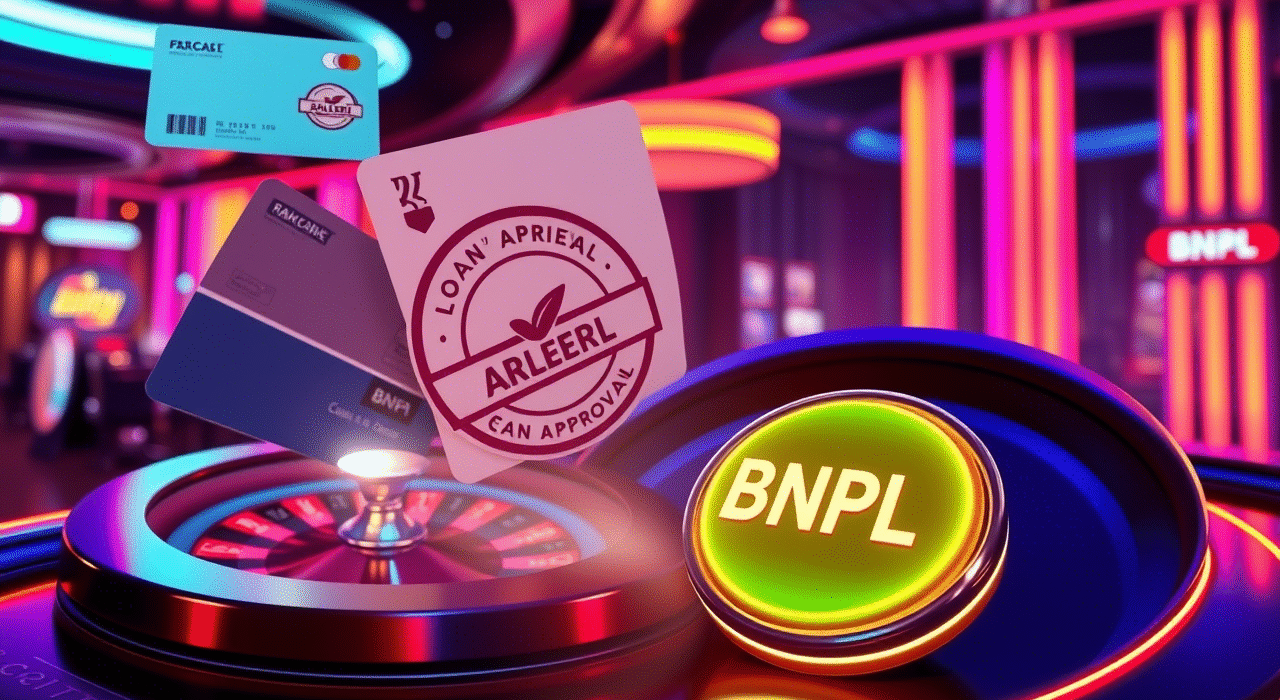💳 The Credit-Fueled Future of Gambling?
In 2025, the gambling industry isn’t just evolving on the surface—with flashier slots or sleeker apps—it’s undergoing a financial transformation. As operators chase higher LTVs and more inclusive player bases, one trend has quietly taken center stage: Buy Now, Pay Later (BNPL)-style gambling models.
The concept is simple, yet controversial: let players wager now and settle the bill later. Sounds familiar? It should. This model has exploded in retail through fintech players like Klarna, Afterpay, and Affirm. Now, some gambling platforms—particularly in emerging markets and crypto-first casinos—are experimenting with similar mechanics.
But does this herald a more flexible player economy… or a dangerous debt spiral disguised as innovation?
🧠 What Is “Buy Now, Bet Later”?
At its core, Buy Now, Bet Later (BNBL) mimics the retail BNPL experience:
- The player places bets using a line of credit or deferred payment option.
- Repayment occurs within a set window (7, 14, or 30 days).
- In some models, no interest is charged unless the payment is late.
Unlike traditional credit cards, BNBL models are often embedded directly into the casino UI—removing friction and making borrowing feel more like a bonus feature than a financial decision.
Some platforms position BNBL as a “risk-free betting mode”, especially during live tournaments or promotional windows. The idea? Play now, pay later… or don’t pay at all if you win.
🚨 The Ethical Minefield
This sounds almost too convenient. And that’s the problem.
Gambling regulators, mental health advocates, and financial watchdogs have sounded the alarm on this model, citing concerns such as:
- Delayed loss perception: Players don’t feel the sting of a loss until much later—if at all—fueling dangerous overplay.
- Debt stacking: A player using BNBL might already have multiple outstanding obligations.
- Lack of oversight: Many BNBL experiments are unregulated, especially in offshore or decentralized environments.
“It’s not just about affordability—it’s about cognitive distortion. You’re rewiring the betting experience into something abstract.”
– Dr. Lena Mirov, Behavioral Economist at BetHealth Institute
💡 BNBL Variants Already in Use
Though still rare in regulated markets, several operators have toyed with the model—under different names:
1. Credit Tokens or Risk-Free Credits
Some casinos issue “advance credit chips” with the promise that if players win, they keep the profit. If they lose, repayment kicks in. Think of it as a hybrid between a free bet and BNPL.
2. Wallet Overdrafts
Certain mobile-first platforms in LatAm and Africa offer micro-loans directly tied to e-wallets, allowing small-scale betting with deferred repayment.
3. “Settle Up Later” Features on Crypto Sites
Several DeFi-inspired casinos allow users to connect wallets and borrow instantly via smart contracts—sometimes even against staked tokens or NFTs. This is BNBL dressed in crypto robes.
🌍 Why This Is Emerging Now
1. Fintech Meets Gambling
The BNPL surge in the wider economy has normalized deferred payment behavior. When consumers expect this flexibility in fashion or groceries, they carry that expectation into iGaming.
2. Younger Audiences, Lower Liquidity
Millennials and Gen Z players are cash flow sensitive but highly engaged. BNBL offers an “inclusive” gateway for participation—though it’s a slippery slope.
3. Crypto Market Influence
DeFi has popularized the concept of collateral-free lending and smart-contract-based wagering. BNBL fits perfectly into that ethos: access before ownership.
🔍 Operator Incentives
From a casino’s perspective, BNBL opens up new growth levers:
- Higher engagement per session
- Player acquisition through flexible entry points
- Data mining on repayment behavior (which can be used for risk scoring and segmentation)
Some even argue it reduces churn, since players are less likely to abandon a platform if they have a pending balance to resolve.
🛑 Regulatory Pushback Is Mounting
UKGC, MGA, and Swedish Gambling Authority have all issued warnings—if not outright bans—on models that mimic credit wagering. The UK’s Gambling White Paper explicitly mentions the risks of borrowing-linked play and “financial products being embedded within betting environments.”
Meanwhile, Australia’s Senate has proposed classifying BNBL-based gambling as “high-risk debt inducement,” which could criminalize operators offering such features.
Yet enforcement remains a challenge—especially in:
- Grey jurisdictions like Curacao
- Crypto-first sites operating under DAOs
- Affiliate networks offering third-party BNBL deals with casinos
🔧 The Tech Behind BNBL in Gambling
1. Embedded Finance APIs
Just like Klarna or Zilch in ecommerce, gambling operators are now exploring plug-and-play BNBL APIs that can:
- Assess player creditworthiness instantly
- Offer repayment plans with variable risk pricing
- Integrate with existing KYC frameworks
2. Smart Contract Lending
In crypto gambling, protocols like Aave and Compound are being repurposed for instant liquidity issuance. Players borrow against tokens, bet, and repay if needed. All without touching fiat.
3. AI Risk Scoring
Some BNBL-based casinos are using machine learning to profile repayment behavior and adjust wagering limits dynamically—blending affordability checks with gameplay personalization.
🧬 What About Player Protection?
Here’s the million-dollar question: Can BNBL ever be ethical?
Some advocates argue that “responsible BNBL” is possible, under certain conditions:
- Hard affordability checks before credit is issued
- Auto-blocks after late repayment
- Gamified reminders and opt-outs for repayment deadlines
- Transparent loss acknowledgment mechanics within the UI
“If operators implement BNBL, they must treat it as a high-risk, highly regulated feature—not a marketing tool.”
– Rachel Goodwin, former Compliance Officer, Kindred Group
However, few current platforms follow these gold standards. In fact, most BNBL mechanics are deployed without robust consumer safeguards.
🤖 The Future: Buy Now, Bet Responsibly?
We could be heading toward a regulated BNBL model, backed by fintech partners and open banking data. In that future:
- Players with stable income could be offered limited wager credit
- BNBL could be offered for specific game types only (e.g., tournaments, not slots)
- Operators might be required to report BNBL usage as credit exposure, similar to how banks do
This would place iGaming BNBL under the purview of financial authorities, not just gambling commissions—a dramatic shift in regulatory scope.
💥 Final Thoughts
“Buy Now, Bet Later” is the perfect example of where fintech innovation collides with gambling ethics. It’s a fascinating, controversial, and incredibly risky development.
For some players, BNBL could mean greater flexibility and smarter bankroll management. For others, it’s a debt trap disguised as empowerment. As operators flirt with the model and regulators scramble to respond, one thing is clear: BNBL isn’t going away. Whether it becomes mainstream or gets regulated into oblivion depends on how responsibly it’s adopted—and who’s really in control.











